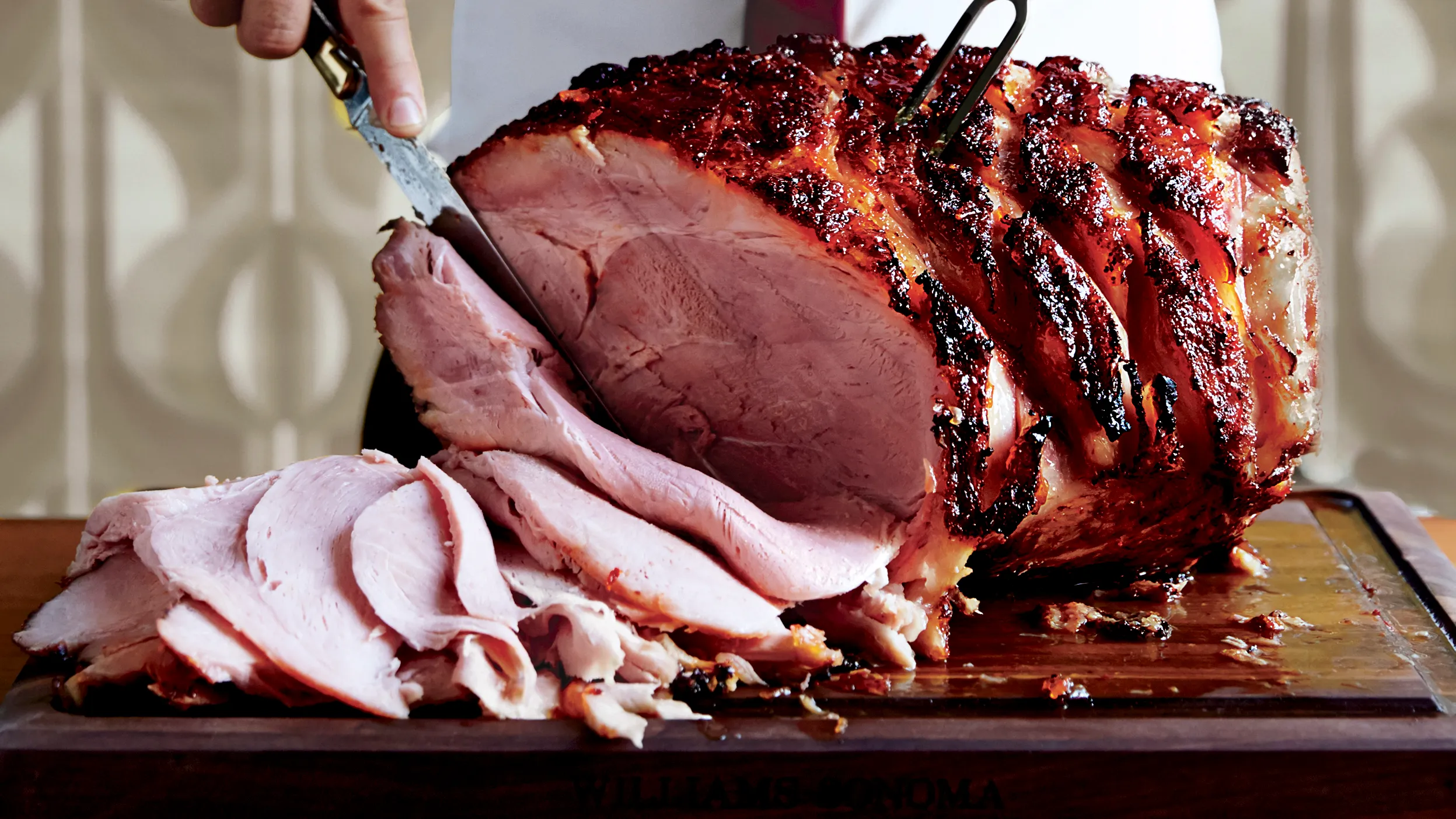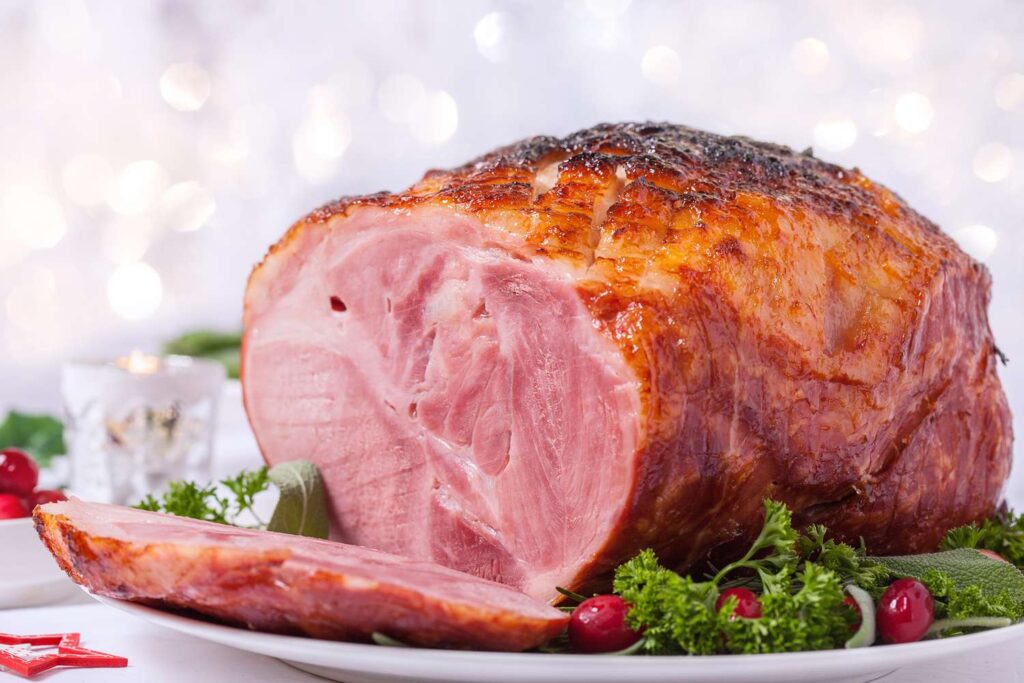How To Cook a Ham is a delicious and versatile ingredient that can be used in a variety of dishes, but many people are intimidated by the idea of cooking it. In this easy guide, we’ll show you How To Cook a Ham step-by-step, from preparing it to trying different cooking methods and recipes. Whether you’re a beginner or an experienced cook, you’ll be able to prepare this vibrant gourd for a wide range of dishes with confidence.

Key Takeaways:
Cooking ham involves several key steps:
Preparation: Start by selecting a ham that fits your preferences, whether it’s bone-in or boneless, cured or uncured. Preheat your oven to the recommended temperature (usually around 325°F or 160°C).
Score the Ham: If your ham isn’t pre-scored, use a sharp knife to create shallow cuts in a diamond pattern on the surface. This helps the glaze penetrate and adds an attractive presentation.
Glazing (optional): If you prefer a glazed ham, mix up your glaze (common ingredients include brown sugar, honey, mustard, and spices) and brush it over the surface of the ham.
Cooking: Place the ham in a roasting pan, either uncovered or loosely covered with foil. The cooking time will vary depending on the size and type of ham. As a general rule, cook it for about 15-20 minutes per pound (450g) until it reaches an internal temperature of 140°F (60°C) for fully cooked ham, or until the desired doneness for partially cooked ham.
Basting (optional): If you want to keep the ham moist and flavorful, baste it with the juices or glaze every 30 minutes or so during the cooking process.
Must Read: How To Cook Garlic Bread Here Is Zaikadoo Recipies
How to Prepare Ham For Cooking
Preparing ham for cooking involves a few important steps to ensure it turns out delicious. Here’s a general guide:
- Thawing: If your ham is frozen, make sure to thaw it in the refrigerator before cooking. This can take several days depending on the size of the ham, so plan ahead. Never thaw ham at room temperature, as it can promote bacterial growth.
- Trimming (optional): Depending on your preference, you may want to trim excess fat from the surface of the ham. Leaving some fat can add flavor and moisture during cooking, but you can remove any large, undesirable pieces if you wish.
- Scoring: If the ham isn’t pre-scored, use a sharp knife to make shallow cuts in a diamond pattern on the surface. This helps the glaze penetrate and adds an attractive presentation.
- Glazing (optional): If you’re planning to glaze your ham, prepare the glaze according to your chosen recipe. Common ingredients for glazes include brown sugar, honey, mustard, and spices. Brush the glaze evenly over the surface of the ham, making sure to coat it well.
- Seasoning (optional): If your ham isn’t pre-seasoned or if you prefer additional flavor, you can season it with herbs, spices, or aromatics before cooking. Common seasonings include cloves, garlic, thyme, rosemary, and black pepper.
- Marinating (optional): If you want to infuse the ham with even more flavor, you can marinate it before cooking. Choose a marinade that complements the natural flavor of the ham, and let it marinate in the refrigerator for several hours or overnight.
- Preheating: Preheat your oven to the temperature specified in your recipe (usually around 325°F or 160°C) while you prepare the ham.
- Cooking: Place the ham in a roasting pan, either uncovered or loosely covered with foil. The cooking time will vary depending on the size and type of ham. Refer to your recipe for specific cooking times and temperatures.
- Basting (optional): If desired, baste the ham with the cooking juices or glaze every 30 minutes or so during the cooking process to keep it moist and flavorful.
- Resting: Once the ham is cooked through, remove it from the oven and let it rest for about 10-15 minutes before slicing. This allows the juices to redistribute and ensures a juicier ham.
Following these steps will help you prepare a delicious ham that’s perfect for any occasion!
Different Methods of How To Cook a Ham
There are several methods you can use to cook ham, each offering unique flavors and textures. Here are some popular ones:
- Baking/Roasting: This is perhaps the most common method for cooking ham. Preheat your oven to around 325°F (160°C). Place the ham in a roasting pan and cook it uncovered or loosely covered with foil. Baste it occasionally with its own juices or a glaze for added flavor. The cooking time will vary depending on the size and type of ham, but generally, it’s about 15-20 minutes per pound (450g).
- Grilling: Grilling adds a smoky flavor to the ham. Preheat your grill to medium heat. Place the ham on the grill and cook it indirectly, away from direct heat, with the lid closed. Rotate the ham occasionally for even cooking. You can also brush it with a glaze or barbecue sauce while grilling for extra flavor.
- Smoking: Smoking is another method that imparts a rich, smoky flavor to the ham. Prepare your smoker according to the manufacturer’s instructions, using wood chips or chunks for smoke flavor. Place the ham in the smoker and cook it at a low temperature (around 225°F or 107°C) until it reaches the desired internal temperature, usually around 140°F (60°C).
- Boiling: Boiling is a method that’s often used for hams that require further cooking, such as cured hams or hams with bones. Place the ham in a large pot and cover it with water or a flavorful liquid like broth or apple cider. Bring the liquid to a simmer and cook the ham until it’s heated through, typically about 20-30 minutes per pound (450g). You can add aromatics like onions, garlic, and spices to the boiling liquid for extra flavor.
- Slow Cooking: Slow cooking is a convenient method that allows you to set it and forget it. Place the ham in a slow cooker and add liquid (such as water, broth, or apple juice) to keep it moist. Cook the ham on low heat for several hours until it’s heated through and tender. You can add seasonings, herbs, or a glaze to the slow cooker for extra flavor.
- Slicing and Searing: This method is great for precooked ham slices. Heat a skillet or grill pan over medium-high heat and sear the ham slices for a few minutes on each side until they’re heated through and lightly browned. This method is quick and adds a nice caramelized flavor to the ham.
Choose the method that best fits your preferences and the type of ham you have, and enjoy the delicious results!
FAQ.
How long do I cook ham?
- Cooking times vary depending on the size and type of ham. As a general rule, cook ham for about 15-20 minutes per pound (450g) in a preheated oven set to 325°F (160°C). However, always refer to your specific recipe or packaging instructions for accurate cooking times.
Do I need to glaze the ham?
- Glazing is optional but adds flavor and enhances the appearance of the ham. You can use a variety of glazes, including brown sugar, honey, mustard, or fruit preserves, depending on your preference.
How do I know when the ham is done?
- Use a meat thermometer to check the internal temperature of the ham. Fully cooked ham should reach an internal temperature of 140°F (60°C). Insert the thermometer into the thickest part of the ham, avoiding contact with the bone.
Should I cover the ham while cooking?
- Whether to cover the ham while cooking depends on personal preference and the recipe. Covering the ham with foil helps retain moisture and can prevent it from drying out, especially during longer cooking times. However, leaving it uncovered can result in a crispier exterior.
Can I cook ham in a slow cooker?
- Yes, you can cook ham in a slow cooker for a convenient and hands-off method. Place the ham in the slow cooker, add liquid (such as water, broth, or juice), and cook on low heat for several hours until heated through and tender.
Can I freeze leftover ham?
- Yes, you can freeze leftover ham for future use. Slice or chop the ham, then place it in an airtight container or freezer bag. Properly stored, it can last in the freezer for up to 2-3 months.
What are some serving suggestions for ham?
- Ham pairs well with a variety of side dishes, such as mashed potatoes, roasted vegetables, salads, or dinner rolls. You can also use leftover ham to make sandwiches, soups, casseroles, or omelets.
Remember to always follow safe food handling practices when cooking ham to prevent foodborne illness. If you have specific dietary restrictions or preferences, consider adjusting recipes accordingly. Enjoy your delicious ham!
Learn: How to Cook Chicken Breast: A Quick and Easy Culinary Journey

Make the Glaze:
- In a small saucepan, mix the brown sugar, Dijon mustard, and apple cider vinegar over medium heat. Stir until the sugar is dissolved and the mixture is well combined.
Glaze the Ham:
- Brush the glaze over the ham, making sure to coat it evenly. If you’ve scored the ham, make sure to get the glaze into the cuts.
Learn: How To Cook Green Beans (Perfect & Crisp-Tender)
Cover and Bake:
- Place the ham in a roasting pan, cover it with aluminum foil, and bake in the preheated oven. The cooking time will depend on the size and type of
- ham. A general rule is to allow about 15-20 minutes per pound (0.45 kg) for pre-cooked hams and 20-25 minutes per pound for uncooked hams.
Baste Periodically:
During the cooking process, baste the ham with the pan juices every 30 minutes or so. This will keep it moist and add more flavor.
Learn: How to Cook Baked Sweet Potatoes: A Simple and Delicious Side Dish
Check the Internal Temperature:
- Use a meat thermometer to check the internal temperature. For pre-cooked hams, it should reach 140°F (60°C). For uncooked hams, the internal
- temperature should reach 160°F (71°C). Make sure to insert the thermometer into the thickest part of the ham without touching the bone.

Bone-In Ham:
- Preheat your oven to 325°F (163°C).
- Score the ham’s surface in a diamond pattern and insert cloves into the intersections if desired.
- Place the ham in a roasting pan, cover it with foil, and bake.
- Allow about 15-20 minutes per pound (0.45 kg) for pre-cooked hams and 20-25 minutes per pound for uncooked hams.
- Baste the ham periodically with pan juices.
- Use a meat thermometer to ensure the ham reaches 140°F (60°C) for pre-cooked or 160°F (71°C) for uncooked ham.
Learn: How To Cook Broccoli
How To Cook a Boneless Ham:
- Follow the same steps as for a bone-in ham, adjusting the cooking time based on the weight.
- Boneless hams may cook slightly faster, so monitor the internal temperature closely.
Smoked Ham:
- Smoked hams are usually pre-cooked and just need reheating.
- Preheat the oven to 325°F (163°C).
- Score the ham and add cloves if desired.
- Place the ham in a roasting pan, cover with foil, and bake, allowing about 15-20 minutes per pound.
- Baste periodically, and check the internal temperature with a meat thermometer, aiming for 140°F (60°C).
Learn: How to cook the perfect steak Steak recipe
Rest Before Serving:
Once the ham reaches the desired temperature, remove it from the oven and let it rest for about 15-20 minutes before carving. This allows the juices to redistribute, keeping the ham moist.
Carve and Serve:
Slice the ham and serve with your favorite sides.
Enjoy your delicious glazed ham! Adjust the ingredients and cooking times based on the specific type and size of ham you have.